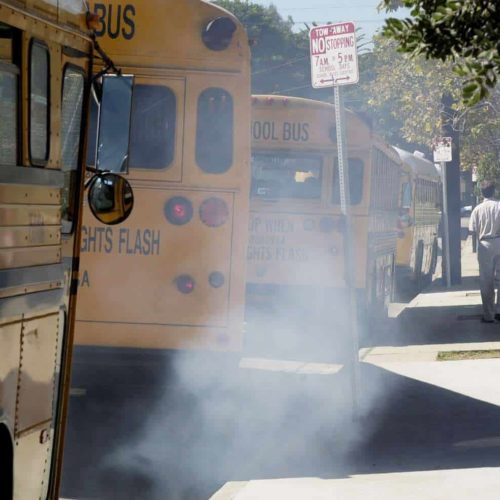Introduction
A much-anticipated government study of more than 12,000 miners — whose publication was delayed by litigation from a group of mining companies — has found that exposure to diesel engine exhaust significantly increases the risk of lung cancer.
For the most heavily exposed miners, the risk of dying from lung cancer was three times higher than it was for those exposed to low doses. For non-smokers, the risk was seven times higher.
“[T]he findings suggest that the risks may extend to other workers exposed to diesel exhaust in the United States and abroad, and to people living in urban areas where diesel exhaust levels are elevated,” Joseph Fraumeni Jr., director of the National Cancer Institute’s Division of Cancer Epidemiology and Genetics, said in a press release Friday morning.
Two papers detailing the study’s results were published in the Journal of the National Cancer Institute. One of them concluded that diesel-induced lung cancer “may represent a potential public health burden.”
In an editorial in the journal, Lesley Rushton, an epidemiologist at Imperial College in London, wrote, “These results indicate that stringent occupational and particularly environmental standards for [diesel exhaust] should be set and compliance ensured to have an impact on health outcomes.” The setting of stricter standards could have broad implications given the ubiquity of diesel engines in trucks, buses, ships, trains and construction equipment.
According to the NCI press release, the study is “the first … based on historical exposure to diesel exhaust to yield a statistically significant, positive increase in lung cancer risk with increasing diesel exposure after taking smoking and other potential lung cancer risk factors into account.”
The Center for Public Integrity reported last month that publication of the $11.5 million study, conceived in 1992 by the NCI and the National Institute for Occupational Safety and Health (NIOSH), had been held up by litigation from the Mining Awareness Resource Group, an industry organization that first challenged the research effort in 1996.
In court filings, lawyers for the group alleged that the study was “inaccurate and faulty” and would “likely spawn public concerns, regulatory actions, and lawsuits.” They received favorable rulings from a federal judge in Louisiana, who ordered the Department of Health and Human Services to give the industry group and the House Committee on Education and the Workforce 90 days to review study data and documents before any papers could be published in scientific journals.
Last August, the judge held HHS — parent of the NCI and NIOSH — in contempt after finding that the agency had withheld study materials from the industry group and the committee. HHS insisted it had done nothing wrong; it appealed the contempt order and proceeded with plans to publish despite stern letters sent to several journals last month by industry lawyer Henry Chajet. In the letters, Chajet warned the journals’ editors that publication “could cause our clients serious harm” and violate court orders.
In an emailed statement to the Center Friday afternoon, Chajet wrote that the Mining Awareness Resource Group — MARG — “is concerned by the [NCI] press release and the reported study conclusions, which are under review by a distinguished group of independent scientific and medical experts. When the review is complete, the experts and MARG will release it to the impacted employees, HHS, the Congress and the public.
“In the interim, MARG expresses its disappointment that HHS refused to provide the data and documents underlying the study to the study participants and independent scientific experts, before issuing its press release, which refusal was in violation of Congressional directives and a 2001 Federal Court Order.”
The second paper published Friday in the Journal of the National Cancer Institute noted that “future occupational and environmental exposure levels to [diesel exhaust] should be less than those encountered during the study” due to the increasing use of cleaner-burning diesel engines.
“However,” the paper’s authors wrote, “there will continue to be [a] legacy of older equipment in operation, the extent and duration of this varying across different countries depending on economic prosperity. Certainly, many workers around the world, in mining and other industries and jobs, continue to be exposed … at levels similar to those observed in this study.”
Allen Schaeffer, executive director of the Diesel Technology Forum, a nonprofit organization in Maryland that represents diesel engine manufacturers, fuel refiners and makers of emission control technology, cautioned against reading too much into the study.
“This research is really retrospective,” Schaeffer said. “It looks at equipment and fuel that in some cases might have been 50 years old. From a practical perspective, equipment and fuel from as much as half a century ago bears little if any resemblance to modern technology.” Emissions from newer diesel engines are “near zero,” he said, and there probably aren’t many older, dirtier engines still in use in the United States.
But John Froines, a professor of toxicology at UCLA who chairs the Scientific Review Panel on Toxic Air Contaminants for the California Environmental Protection Agency, said the study is “extremely important” in that it reinforces earlier research suggesting diesel exhaust could cause cancer. California deemed the pollutant a carcinogen in 1998 and adopted strict regulations limiting emissions of diesel particulate matter.
The International Agency for Research on Cancer (IARC), part of the World Health Organization, considers diesel exhaust “probably carcinogenic to humans.” But IARC is scheduled to revisit the science in June and could be swayed by the HHS miner study to list diesel as a known cancer-causing agent. That, in turn, could lead to new regulations and make it more difficult for industry to defend itself in lawsuits.
Update (Mar. 2, 3:46pm): This story was updated to add comments from industry and public health representatives.


Join the conversation
Show Comments